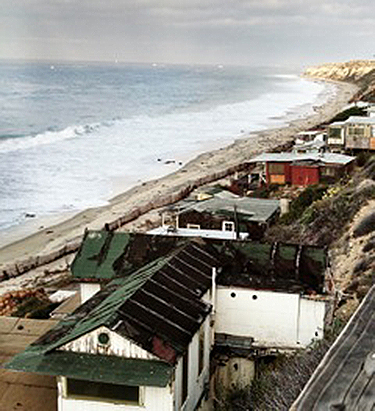
No cars. No TV. No radio. No internet. No landline phones. Just a little light at night and a little water in the shower. Furniture, decor and art from the 1920s. Wood frame buildings clinging to a cliff or squatting on the sand beside the ocean. Nothing newer than1938. An entire town built in the elbow of a gentle cove, then deserted, then re-inhabited as a state park.
The harmonies of our lives play out to the rhythms of crashing surf. The markers of our days are sunrise and sunset, waves and clouds by day, stars and a red, red moon by night.
In the middle of one of the largest, densest most modern and technologically savvy agglomeration of people, subdivisions, malls and freeways in the United States, we walk everywhere because there is no other way of getting anywhere: up the 71 steps from the beach to our cottage. Up another long flight of stairs to a breakfast shack. Across California Route 1 to an absurdly upscale shopping center with a free Peruvian concert and, uniquely, a seafood restaurant that manages somehow to be simultaneously good, cheap and informal.
And best of all, for miles in both directions a beach that is a narrow corridor of sand dividing crumbling vertical cliffs from the endless sweep of the blue Pacific.
This is Crystal Cove Cottages, part of a California state park and a place that shouldn’t exist—and almost didn’t.
“Our unique objective,” a Crystal Cove pamphlet declares, “is to create a rustic, relaxing ambiance of a walk back in time in our National Historic District by the seashore.”
Quintessentially Californian, Crystal Cove began life as a movie set in 1917. Hollywood planted palm trees, constructed buildings and made, among other films, the original Treasure Island. The village attracted publicity as a “South Seas Paradise” and a second Hawaii. Locals built shacks and permanent tent homes, then cottages and houses. They returned every year for reunions and created a community spirit.
The land became part of the gigantic Irvine Company, which bought up most of Orange County. In the early 1960s the company planned a vast resort with 10 luxury hotels and thousands of homes. The plans fell through and the company sold the land to the state of California. Then in the 1990s the state began its own planning for a megaresort. Area residents and those who remembered the old Crystal Cove fought back and ultimately saved their beachside gem.
Today 31 of the old houses have been renovated. One serves as a headquarters and the others are rented out for a few dollars to those lucky enough and persistent enough to get a reservation. Seventeen additional houses are to be renovated as part of the next phase of construction, for which planning and fund raising are now in progress.
The houses have been renovated to look as much as possible like the original cottages of pre-World War II America, a simpler and more ambulatory age when people actually talked to each other instead of texting. For a few days my wife and I imbibed the nectar of this age, and I confess we found it intoxicating.
California has probably the most magnificent scenery in the country but for the most part it is the most unpleasant place in the land to get around. There are just too many cars driving too fast on too many roads that, no matter how many billions of dollars are spent on them, can’t keep up with demand. California is exhibit one proving the failure of the experiment in constructing a dense urban civilization based entirely on the privately owned passenger car and the freight-moving truck.
That in the midst of this tangled and mangled civilization an enclave like Crystal Cove still exists is evidence that we have retained a smidgeon of sanity, and in that smidgeon lies what hope we have for our future.

October 30, 2014